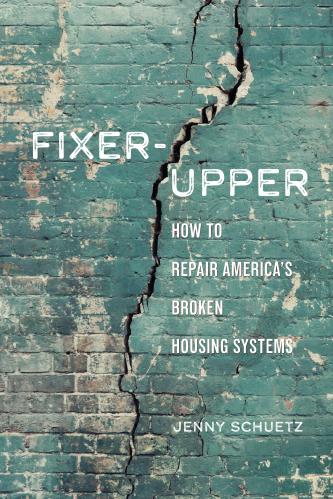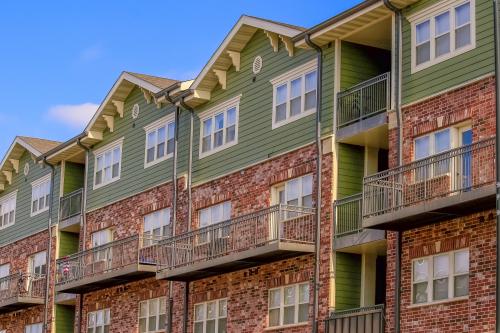Fixer Upper: How to Repair America’s Broken Housing Systems, by author Jenny Schuetz, is available for purchase.
Long before the COVID-19 pandemic made supply chain snags a topic of dinner table conversation, the U.S. was already struggling with broken production systems in a key industry: housing.
The U.S. has failed to build enough homes to meet the demand created by population and job growth since the Great Recession—and even earlier in some parts of the country. The shortfall is particularly apparent in metro areas with an abundance of well-paying jobs and amenities; the places where many people want to live consistently build too little housing. For instance, the San Francisco Bay Area added only one home for every seven new jobs created between 2010 and 2015, while rents increased more than 40% during the same period. Similar patterns are observable within cities: Affluent, high-amenity neighborhoods such as Georgetown in Washington, D.C., Greenwich Village in New York City, and Hancock Park in Los Angeles have added minimal amounts of housing over the past 30 years.
In my new book, Fixer-Upper: How to Repair America’s Broken Housing Systems, I show that anemic housing production in high-opportunity places is not primarily due to container ships with lumber backed up outside ports or a “Great Resignation” among construction workers. Rather, the policies that regulate land use and housing production make it extremely difficult to add more homes in desirable locations. In every state across the country, it is illegal for a landowner or developer to build new homes (or alter or tear down existing homes) without explicit approval from the local government. And the people who already live in those places wield a variety of legal and political tools—zoning laws, historic preservation, environmental regulations, and direct lobbying of elected officials—to block attempts to build more homes.
It is understandable that current residents want an opportunity to share concerns over changes to their neighborhood; adding homes and people can increase the demands on local schools, roads, and parks. But giving existing residents—especially long-term homeowners—veto power over new development creates economic, social, and environmental costs that are borne by the rest of society. Researchers estimate that restrictive land use regulations slowed GDP growth in the U.S. by about 36% between 1964 and 2009. That’s because firms in high-cost regions have difficulty hiring and retaining workers, restricting potential growth and innovation.
And these costs are not equally shared. Restrictive zoning in affluent, mostly white communities limits economic mobility for low- and moderate-income households, while reinforcing economic and racial segregation. Roughly 10 million renter households spend more than half their income on housing, leaving them too little money for food, health care, and other necessities. Black, Latino or Hispanic, and Native American families are more likely to live in areas with higher exposure to flooding, fire, extreme heat, and other climate risks—reflecting long-standing discrimination in real estate markets.
While land use regulations are the most obvious contributor to our dysfunctional housing system, a number of other policies interact to reinforce bad outcomes. Reflecting subsidies in the federal tax code, home equity is the largest financial asset for middle-income households; these homeowners are thus financially and personally motivated to fight against changes to their neighborhood that they perceive as threats to their property values. And local governments are heavily dependent on property taxes to pay for public services such as schools and parks; many localities are therefore reluctant to approve small, moderately priced homes that they believe will create greater demands on services than the tax revenues they generate (although the real fiscal impacts are often more complicated).
The flip side of our broken housing system is that the U.S. has built—and continues to build—too many homes in the wrong places, environmentally speaking. People who have jobs in downtown Los Angeles but cannot move to close-in neighborhoods like Hancock Park are pushed toward distant but cheaper neighborhoods, like Pacoima or Riverside. That’s not just a problem for priced-out households—longer commutes lead to increased greenhouse gas emissions and environmental damage for the entire region. Expanding housing supply through sprawling single-family subdivisions at the urban fringe rather than infill development in existing neighborhoods has increased the number of people and homes living in environmentally risky locations, including wildfire-prone areas in the West.
What can be done to fix this broken housing system and increase the availability and affordability of homes in high-demand locations, mitigate climate impacts, and expand access to economic opportunity? Bad outcomes result from complex interactions between federal, state, and local policies—so, reaching better outcomes will require substantial policy changes across all levels of government.
Local governments should reform the rules governing housing production, to allow diverse types of housing at a wider range of prices in every community. State governments play a vital role in overseeing localities, and could create financial carrots and sticks that nudge localities toward pro-housing reforms. The federal government should expand direct financial support for low-income households; enabling every person to live in decent-quality, stable, affordable housing should be a core tenet of a strong social safety net.
The main obstacle to fixing our broken housing system is not the absence of good policy ideas, but wicked hard politics. Those who benefit from the status quo—including many middle- and upper-income homeowners—are understandably reluctant to allow changes. Those who stand to gain the most from change (younger households, especially renters) are underrepresented among elected officials, often face barriers to political participation, and have not yet built durable coalitions around shared policy goals. The nascent pro-housing movement is beginning to notch modest but tangible legislative wins at the local and state level, from Minneapolis to Raleigh, N.C. and Massachusetts to Utah. Whether these wins translate to momentum for larger-scale systemic reforms, however, is still unclear.







Commentary
Dysfunctional policies have broken America’s housing supply chain
February 22, 2022